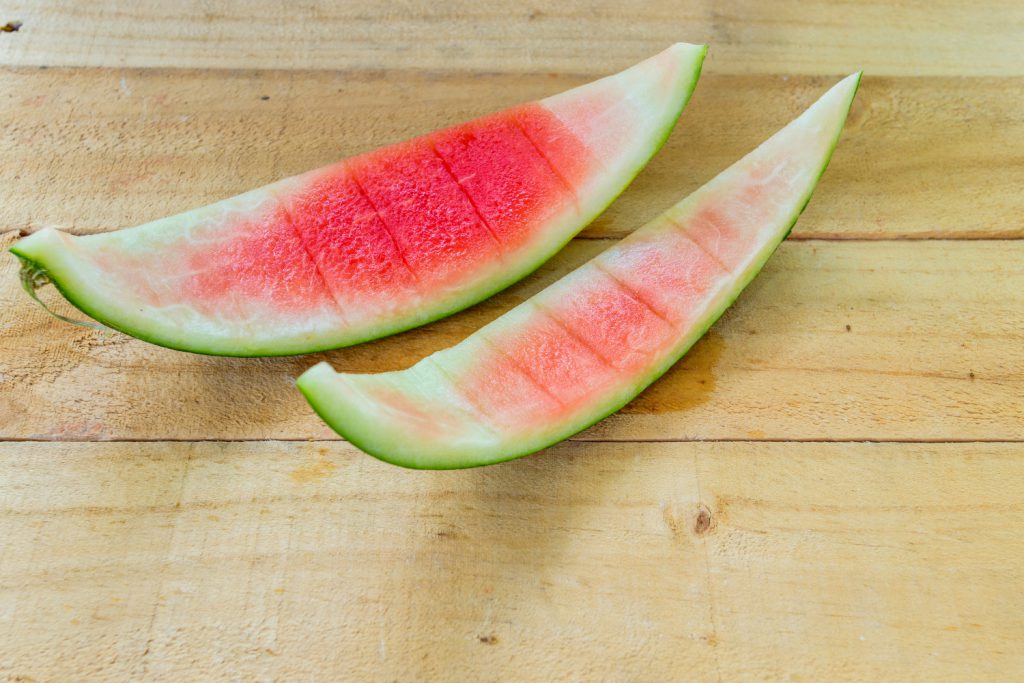
We have all been guilty of sharing human food with our furry friends. As much as we try to avoid it and have our dogs stick to the dog food, we lose. Sometimes these small incidences of sharing food come with several consequences. Anything that does not belong in the conventional dog diet can cause problems. Well, the real question is can dogs eat watermelon rind?
The solution would be not to give dogs the food they are eyeing. It seems like a long shot, and the possibility of it happening is almost zero to none. Another solution can be the complete know-how about the food you are sharing. It will help develop an understanding of what we can and cannot share with our four-legged friends.
It is imperative to remember that a dog’s digestive working is much different from the digestive working. Therefore before feeding dogs anything, it is important to see if the food is appropriate for dogs or not. Many of us think that we can offer watermelon rind during dogs’ training for something different and when you are out for an adventure.
When it comes to watermelon, it is a well-established fact that dogs can eat it. But can they eat the rind as well? The answer is a big NO! Dogs cannot eat watermelon rind because it can cause serious digestive issues. Dogs are inherently unable to consume the covering. It can cause serious digestive troubles. Therefore, there is no need to experiment with it as it can have serious consequences.
You might also like our recent blog post on Dog Food to Prevent Gas available on a separate page.
What makes rind a health hazard to dogs?
The outermost covering of fruits and vegetables is commonly known as the peel. A less common word for it is the rind. This covering varies in color, thickness, edibility, and texture from fruit to fruit. While the peel can be thin and edible for dogs, as in apples, watermelon peel is a whole different thing. If you believe that it is ok to give a bit of watermelon rind to your dog, you contribute to something hazardous for your pet.
There are several proven health benefits of rind consumption in humans. Like the flesh of the watermelon, the rind also contains a wide variety of vitamins and minerals. It is a good source of vitamin B complex, and many people opt for its consumption.
Although the dogs may require these vitamins, watermelon rind should not be the source. This rind is not to be eaten by dogs. It can also pose some serious health issues.
Thickness: Watermelon is the juiciest fruit out there. One of the contributing factors to this juiciness is the outer covering. Nature designed this peel to be very hard and thick. It prevents the evaporation of water on the inside. Thus, the nutrients and water content are not lost to the environment because of this rind. Unfortunately, the same characteristics that are a blessing for humans make this covering non-edible and rather hazardous to dogs.
When the dog consumes the watermelon rind, it stays in the stomach for a long. With time, this watermelon rind in the stomach starts rotting and poses serious health issues for your pet. Also, the rind is hard to chew, and that makes it a difficult treatment for dogs.
Hardness – In addition to the rind being thick, its hardness also plays an important role in making the rind unsafe for consumption. This makes it very hard to bite and consume in smaller pieces. Dogs, as we know, are hasty eaters. They seldom chew anything properly. If left unsupervised, these impulsive creatures will swallow the food as a whole. This adds to the rinds being a choking hazard to dogs. Choking is also a regular incident for dogs because they eat very fast, and when it comes to watermelon rind, choking is almost obvious.
Non-digestible – Dogs are among the carnivorous quadrupeds. Their remarkable digestive system and oral cavities make it very easy to consume meat in raw form. This, however, cannot be applied to plant-based diets. A carnivorous system, unlike an herbivorous system, is not designed to process plants and their derivatives. This makes the rind indigestible to dogs. As watermelon rind belongs to the fruits category, it is obvious that you know that the stomach of a dog is not designed to consume anything properly if it is not meat.
What happens if your dog consumes the rind?
Now that we know the rinds are harmful to dogs. Let’s look into how the problem after rind consumption manifests in your pet. As dogs cannot process it, most of these symptoms are related to the digestive system and indigestion. Keep in mind that your dogs can have only a few of the below mentions symptoms, not all.
- Diarrhea – Same as humans, dogs react to any indigestible substance in the form of loose stool. When the dog consumes the rind of the watermelon, then it will have the symptoms of diarrhea. This symptom is also dependent on the amount of rind consumed. If there is more rind, there will be more loose motions. Thus, diarrhea is mostly associated when the peel is devoured in relatively large amounts.
- Vomiting – The digestive system takes the entity it cannot process as a foreign object. It tends to get it out of the system in whatever ways it can. For example, the bowel movement of a dog will not accept watermelon rind, and it will try to throw it out of the stomach. Although it is rare, vomiting can also serve as the route to get it out. There is also the possibility for your dogs to show the symptoms of diarrhea and vomiting simultaneously.
- Choking – Dogs are hasty eaters; therefore, it is not nice to give them something in a big chunk. The thickness and hardness of the rind also make it a choking hazard. It can get stuck in the throat of your dog. Hence, it would be a good idea to avoid it altogether.
- Gastrointestinal obstruction – Watermelon rind can also lead to the blockage of the intestines. Bite-size pieces or chewing may have avoided the choking, but the gut cannot process it hard. This makes it difficult for the dog to digest. They can get stuck in the intestines.
What to do if your dog consumes the rind in excess?
Excessive consumption can cause one of the symptoms to appear in dogs. Here is what you can do.
If you are sure that your dog has consumed rind in excess, keep a close eye on it and look out for symptoms. Diarrhea and vomiting symptoms can be resolved at home and do not require any medical attention. When you feel that your dog is showing diarrhea symptoms or vomiting, the best thing is to keep it hydrated for long. Water consumption will sort this problem out in the comfort of your home.
Do not withhold foods and fluids as it can lead to deficiencies. It is also appropriate if you switch your dog to a bland and highly digestible diet. It will help in forming the bulk of the stool and get anything problematic out of the system.
In gastrointestinal obstruction, pain and straining in defecation may occur along with watery stool with blood. In this scenario, seek medical attention. Also, make sure that you are not trying any homemade remedies because they may or may not work. When the dog is showing extreme symptoms, the best thing to do is to take it to a vet to have proper medical attention.
Conclusion
The best thing you can do is keep the dog on a diet made for it. Dogs are carnivorous, and their digestive working is much different from humans. Things you can consume without any health implications can be poison to dogs. Why humans can enjoy watermelon rind may be harmful to a dog.
If you enjoy sharing your food with your dog, make sure it not hazardous. Always try to give the dog something it can tolerate. Make sure your dog can tolerate what you are feeding. Watermelon rind is not healthy for dogs. Thus, keep your dog away from this poison at all costs.
We know that you love your dog, but that doesn’t mean that you can share with it whatever you like. Watermelon rind is not food made for a dog so make sure that it doesn’t have it, even a bit.
Can Dogs Eat Acorns? Dogs cannot eat acorns because it contains tannins that are extremely toxic for your dog.
